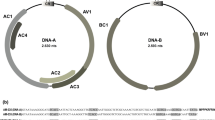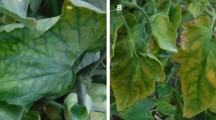Abstract
A begomovirus causing mottling and leaf deformation in tomato from the State of Mérida was cloned and sequenced. The virus has a bipartite genome comprised of a DNA-A (2,572 nucleotides) and a DNA-B (2,543 nucleotides) with a genome organization typical of New World begomoviruses. Both components share a common region of 115 nucleotides with 98 % sequence identity. Phylogenetic analysis indicated that while no virus sequences were closely related, the A component was distantly related to those of two other tomato-infecting viruses, tomato leaf deformation virus and Merremia mosaic virus; and the DNA-B, to those of pepper huasteco yellow vein virus and Rhynchosia golden mosaic Yucatan virus. The DNA-A and DNA-B sequences were submitted to GenBank (accession no. AY508993 and AY508994, respectively) and later accepted by the International Committee on Taxonomy of Viruses as the genome of a member of a unique virus species with the name Tomato yellow margin leaf curl virus (TYMLCV). Tomato (Solanum lycopersicum L. ‘Fl. Lanai’) plants inoculated with cloned TYMLCV DNA-A and DNA-B became systemically infected and showed chlorotic margins and leaf curling. The distribution of TYMLCV in tomato-producing states in Venezuela was determined by nucleic acid spot hybridization analysis of 334 tomato leaf samples collected from ten states using a TYMLCV-specific probe and confirmed by PCR and sequencing of the PCR fragment. TYMLCV was detected in samples from the states of Aragua, Guárico, and Mérida, suggesting that TYMLCV is widely distributed in Venezuela.



Similar content being viewed by others
References
Albuquerque LC, Martin DP, Avila AC, Inoue-Nagata AK (2010) Characterization of tomato yellow vein streak virus, a begomovirus from Brazil. Virus Genes 40:140–147
Argüello-Astorga GR, Guevara-González RG, Herrera-Estrella LR, Rivera-Bustamante RF (1994) Geminivirus replication origins have a group-specific organization of iterative elements: a model for replication. Virology 203:90–100
Argüello-Astorga GR, Ruiz-Medrano R (2001) An iteron-related domain is associated to Motif 1 in the replication proteins of geminiviruses: identification of potential interacting amino acid-base pairs by a comparative approach. Arch Virol 146:1465–1485
Bai Y, Lindhout P (2007) Domestication and breeding of tomatoes: what have we gained and what can we gain in the future? Ann Bot 100:1085–1097
Briddon RW, Patil BL, Bagewadi B, Nawaz-ul-Rehman MS, Fauquet CM (2010) Distinct evolutionary histories of the DNA-A and DNA-B components of bipartite begomoviruses. BMC Evol Biol 10:97
Brown JK, Idris AM, Torres-Jerez I, Banks GK, Wyatt SD (2001) The core region of the coat protein gene is highly useful for establishing the provisional identification and classification of begomoviruses. Arch Virol 146:1581–1598
Brown JK, Mills-Lujan K, Idris AM (2011) Phylogenetic analysis of Melon chlorotic leaf curl virus from Guatemala: Another emergent species in the Squash leaf curl virus clade. Virus Res 158:257–262
Coutts RH, Coffin RS, Roberts EJ, Hamilton WD (1991) The nucleotide sequence of the infectious cloned DNA components of Potato yellow mosaic virus. J Gen Virol 72:1515–1520
Debrot E, Herold F, Dao F (1963) Nota preliminar sobre un “mosaico amarillento” del tomate en Venezuela. Agron Trop 13:33–41
Fauquet CM, Briddon RW, Brown JK, Moriones E, Stanley J, Zerbini M, Zhou X (2008) Geminivirus strain demarcation and nomenclature. Arch Virol 153:783–821
Fontes EP, Gladfelter HJ, Schaffer RL, Petty IT, Hanley-Bowdoin L (1994) Geminivirus replication origins have a modular organization. Plant Cell 6:405–416
Gutierrez C (2000) DNA replication and cell cycle in plants: learning from geminiviruses. EMBO J 19:792–799
Guzman P, Arredondo C, Emmatty D, Portillo R, Gilbertson R (1997) Partial characterization of two whitefly-transmitted geminiviruses infecting tomatoes in Venezuela. Plant Dis 81:312
Hall TA (1999) BioEdit: a user-friendly biological sequence alignment editor and analysis program for Windows 95/98/NT. Nucl Acids Symp Ser 41:95–98
Lazarowitz SG (1992) Geminiviruses: genome and structure and gene function. Rev Plant Sci 11:327–349
Legg JP, Thresh JM (2000) Cassava mosaic virus disease in East Africa: A dynamic disease in a changing environment. Virus Res 71:135–149
Londoño A, Riego-Ruiz L, Argüello-Astorga GR (2010) DNA-binding specificity determinants of replication proteins encoded by eukaryotic ssDNA viruses are adjacent to widely separated RCR conserved motifs. Arch Virol 155(7):1033–1046
Marquez-Martin B, Aragon-Caballero L, Fiallo-Olive E, Navas-Castillo J, Moriones E (2011) Tomato leaf deformation virus, a novel begomovirus associated with a severe disease of tomato in Peru. Eur J Plant Pathol 129:1–7
Martin DP, Lemey P, Lott M, Moulton V, Posada D, Lefeuvre P (2010) RDP3: a flexible and fast computer program for analyzing recombination. Bioinformatics 26:2462–2463
Morales F, Lastra R, Uzcategui R, Calvert L (2001) Potato yellow mosaic virus: a synonym of Tomato yellow mosaic virus. Arch Virol 146:2249–2253
Morales FJ, Anderson P (2001) The emergence and distribution of whitefly-transmitted geminiviruses in Latin America. Arch Virol 146:415–441
Nava A, Ochoa F, Trujillo G, Geraud F, Hernández L, Lastra R, Rivas G (1996) Detección de virus en zonas productoras de tomate (Lycopersicon esculentum Mill) en Venezuela. I Estados Aragua y Zulia. Rev Fac Agron (LUZ) 13:285–292
Nava A, Trujillo G, Chirinos D, Rivero G (1997) Detección de virus en zonas productoras de tomate (Lycopersicon esculentum Mill) en Venezuela. II Estados andinos (Mérida, Táchira y Trujillo). Rev Fac Agron (LUZ) 14:611–624
Nava A, Trujillo G, Chirinos D, Rivero G (1998) Detección de virus en zonas productoras de tomate (Lycopersicon esculentum Mill) en Venezuela. III Estados centro occidentales (Lara, Portuguesa, Barinas y Cojedes). Rev Fac Agron (LUZ) 15:23–29
Nava A, Trujillo G, Chirinos D, Rivero G (1998) Detección de virus en zonas productoras de tomate (Lycopersicon esculentum Mill) en Venezuela. IV Estado Zulia. Rev Fac Agron (LUZ) 15:135–141
Nava AR, Patte CP, Hiebert E, Polston JE (2006) Detection and variability of begomoviruses in tomato from the Andean states of Venezuela. Plant Dis 90:61–66
Patel VP, Rojas MR, Paplomatas EJ, Gilbertson RL (1993) Cloning biologically active geminivirus DNA using PCR and overlapping primers. Nucleic Acids Res 21:1325–1326
Patil BL, Fauquet CM (2009) Cassava mosaic geminiviruses: actual knowledge and perspectives. Mol Plant Pathol 10:685–701
Polston JE, Anderson PK (1997) The emergence of whitefly-transmitted geminiviruses in tomato in the Western Hemisphere. Plant Dis 81:1358–1369
Polston JE, McGovern RJ, Stanley PA, Schuster DJ (1993) Host range of Tomato mottle virus, a new geminivirus infecting tomato in Florida. Plant Dis 77:1181–1184
Rani RV, Karthikeyan AS, Anuradha S, Veluthambi K (1996) Genome homology among geminiviruses infecting Vigna, cassava, Acalypha, Croton and Vernonia. Curr Sci 70:63–69
Rath P, Rajaseger G, Goh CJ, Kumar PP (1998) Phylogenetic analysis of Dipterocarps using random amplified polymorphic DNA markers. Ann Bot 82:61–65
Ribeiro SG, Ambrozevícius LP, Avila AC, Bezerra IC, Calegario RF, Fernandes JJ, Lima MF, de Mello RN, Rocha H, Zerbini FM (2003) Distribution and genetic diversity of tomato-infecting begomoviruses in Brazil. Arch Virol 148:281–295
Roberts EJ, Bucs KW, Coutts RH (1988) Characterization of Potato yellow mosaic virus as a geminivirus with a bipartite genome. Intervirology 29:162–169
Rojas A, Kvarnheden A, Marcenaro D, Valkonen JP (2005) Sequence characterization of tomato leaf curl Sinaloa virus and tomato severe leaf curl virus: phylogeny of New World begomoviruses and detection of recombination. Arch Virol 150:1281–1299
Rojas MR, Gilbertson RL, Russell DR, Maxwell DP (1993) Use of degenerate primers in the polymerase chain reaction to detect whitefly-transmitted geminiviruses. Plant Dis 77:340–347
Romay G, Chirinos D, Geraud-Pouey F, Desbiez C (2010) Association of an atypical alphasatellite with a bipartite New World begomovirus. Arch Virol 155:1843–1847
Romay G, Geraud-Pouey F, Chirinos DT, Morales F, Herrera E, Fernández C, Martínez AK (2010) Transmission of tomato Venezuela virus by Bemisia tabaci (Gennadius) (Hemiptera: Aleyrodidae), in Maracaibo, Venezuela. Neotrop Entomol 39:266–274
Sawant SV, Singh PK, Tuli R (2000) Pretreatment of microprojectiles to improve the delivery of DNA in plant transformation. BioTechniques 29:246–248
Tamura K, Nei M (1993) Estimation of the number of nucleotide substitutions in the control region of mitochondrial DNA in humans and chimpanzees. Mol Biol Evol 10:512–526
Tamura K, Peterson D, Peterson N, Stecher G, Nei M, Kumar S (2011) MEGA5: molecular evolutionary genetics analysis using maximum likelihood, evolutionary distance, and maximum parsimony methods. Mol Biol Evol 10:2731–2739
Uzcategui RC, de Lastra R (1978) Transmission and physical properties of the causal agent of mosaico amarillo del tomate (tomato yellow mosaic). Phytopathology 68:985–988
Zambrano K, Carballo O, Geraud F, Chirinos D, Fernández C, Marys E (2007) First report of tomato yellow leaf curl virus in Venezuela. Plant Dis 91:768
Zambrano K, Fernández-Rodríguez T, Marys E (2012) Molecular characterization of a new begomovirus that infects Euphorbia heterophylla and Solanum lycopersicum in Venezuela. Arch Virol 157:379–382
Zambrano K, Geraud-Pouey F, Chirinos D, Romay G, Marys E (2011) Tomato chlorotic leaf distortion virus, a new bipartite begomovirus infecting Solanum lycopersicum and Capsicum chinense in Venezuela. Arch Virol 156:2263–2266
Acknowledgements
The authors would like to acknowledge the support of A. Londoño through an Innovation Fund Grant provided by the University of Florida, Office of the Dean for Research, and to S. Duffy for critical reviews of the manuscript.
Author information
Authors and Affiliations
Corresponding author
Electronic supplementary material
Below is the link to the electronic supplementary material.
705_2012_1501_MOESM2_ESM.tif
Supplementary material 2 Genome organization of tomato yellow margin leaf curl virus (TYMLCV). Location and extent of open reading frames and primers used in the study are noted. (TIFF 146 kb)
Rights and permissions
About this article
Cite this article
Nava, A., Londoño, A. & Polston, J.E. Characterization and distribution of tomato yellow margin leaf curl virus, a begomovirus from Venezuela. Arch Virol 158, 399–406 (2013). https://doi.org/10.1007/s00705-012-1501-x
Received:
Accepted:
Published:
Issue Date:
DOI: https://doi.org/10.1007/s00705-012-1501-x




